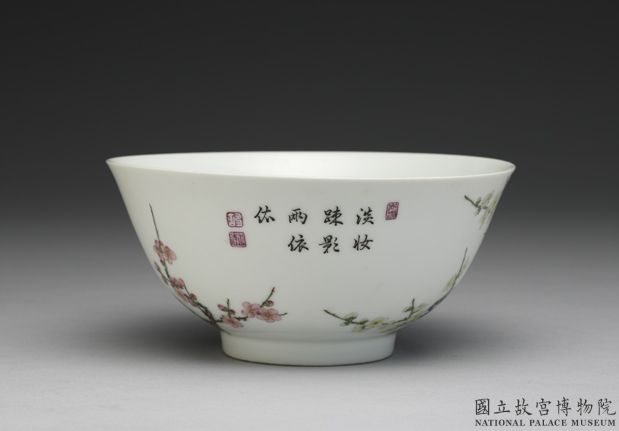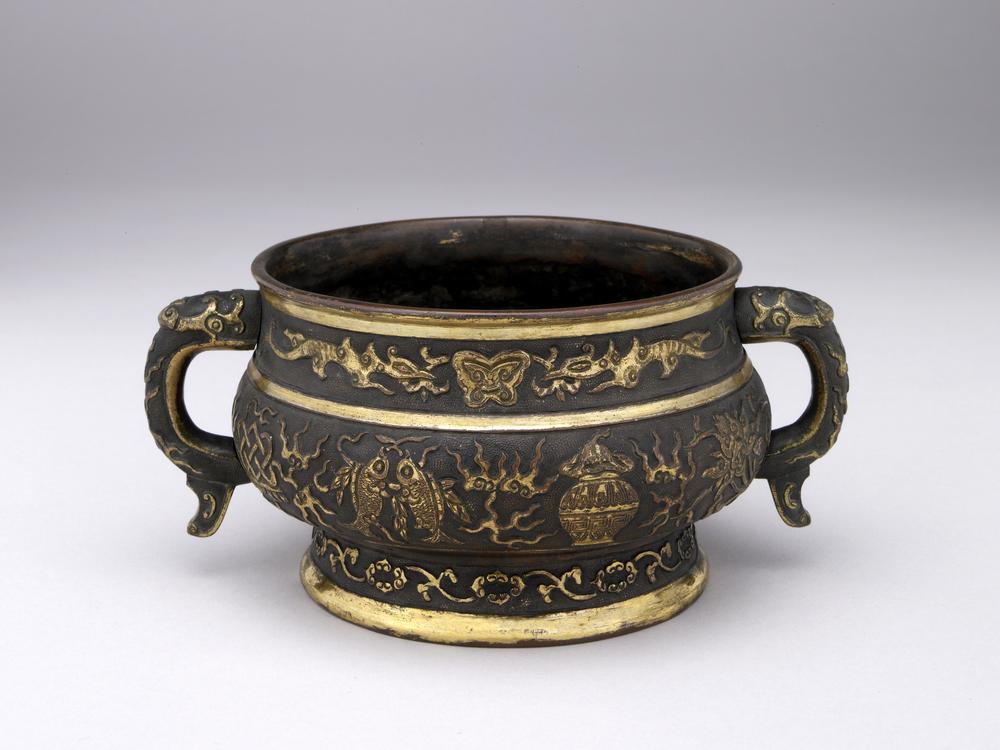Period:Western Zhou dynasty Production date:11thC BC-8thC BC
Materials:jade
Technique:
Subjects:bird
Dimensions:Width: 5.70 centimetres
Description:
Mottled greenish-brown jade plaque.
IMG
![图片[1]-plaque BM-2022-3034.140-China Archive](https://chinaarchive.net/Western Zhou dynasty/Jades/716_1.jpg)
Comments:The flat plaque of trapezoidal form, decorated on one side with a single fenghuang standing in profile, with large, hooked beak, curled crest and long tail feathers arched over the bird’s back and head and beneath its body, with a pair of conjoined fenghuang with backward-turned heads on the reverse, all executed in grooved lines of varying width, a narrow tab projecting from the lower edge on one side pierced with twelve small, biconical holes and a slight projecting ridge on the reverse of the upper edge pierced with six holes which exit in the side of the plaque just below, the green and brown mottled stone extensively altered in burial to a dark buff colour on one side, chips. JR: Plaque decorated on both sides with birds. Western Zhou period, 10-9th century BC. CM: Two examples of plaques which share some of the features of 716: these both have two birds back to back, but, unlike 716 [2014,AsiaLoan,1.202], the bodies of the birds are detached not joint. 1. Provenance tomb at Fengchucun, Qishan county, Shaanxi province. Perforations: 6 on one side and 10 on the other. all perpendicular. Decoration: one side plain, the other side displays two birds back to back( similar heads and crests). Bibligoraphy: Liu Yunhui, Zhouyuan yuqi, Xian, Zhonghua Wenwu Xuehui, 1996, pl. 207, p. 200. 2. Provenance: tomb M92 at Tianma-Qucun, Quwo county, Shanxi province. Perforation: 6 straight on one side and 10 perpendicular on the other (the two types of holes correspond to those on 716). Decoration on both sides, rendered in open-work, two birds back to back (similar heads and crests). Bibliography: Wenwu no. 7, 1995, figs. 20-21, p. 18. CHRISTIES: A trapezoidal plaque with feng has been excavated from Puducun, Changan, Shaanxi, Kaogu xuebao, 1957:1, p. 84, pl. V1:4; and agian in Jade Carvings in Chinese Archaeology, col. 1, Hong Kong, 1987, pl. XXV11:2AB. The motifs of fenghuang on the front and reverse of this piece are identical to the high quality of the Sackler carving. Like the latter, the birds on front and rewverse faces are incised with double lines. The Puducun plaque does not carry biconical holes. In shape and decor the two, Puducun and Sackler pieces, are similar. Another plaque of this shape and size decorated with back to back fenghuang, but in which the bodies have been reduced to circular scroll motifs, the legs and claws eliminated, was excavated at Fengchucun, Qishan County, Shaanxi, Wenwu, 1979:10, p. 34, fig. 8. Also compare the similar plaque from the Collection of C.T.Loo, Paris, illustrated by Salmony, Carved Jade of Ancient China, Berkeley, California, 1928, pl. CXXV:7 which is also carved with a fenghuang in profile and has holes pierced through the upper and lower edges. Both the present plaque and the C.T. Loo example appear to be related to another trapezoidal plaque pierced with ‘ox-=nose’ loop holes along the upper and lower edges but with different decoration, included in the exhibition, Chinese Archaic Jades from the Kwan Collection, the Art Gallery, University of Hong Kong, 1994, Catalogue no. 126, where Yang Boda illustrates a line drawing of a similar ornament hung with pendent beads excavated from a Western Zhou burial at Pingdingshan in Henan province, where it was found at chest level and surmised to be part of a pectoral ornament. See 49 [2014,AsiaLoan,1.201].
Materials:jade
Technique:
Subjects:bird
Dimensions:Width: 5.70 centimetres
Description:
Mottled greenish-brown jade plaque.
IMG
![图片[1]-plaque BM-2022-3034.140-China Archive](https://chinaarchive.net/Western Zhou dynasty/Jades/716_1.jpg)
Comments:The flat plaque of trapezoidal form, decorated on one side with a single fenghuang standing in profile, with large, hooked beak, curled crest and long tail feathers arched over the bird’s back and head and beneath its body, with a pair of conjoined fenghuang with backward-turned heads on the reverse, all executed in grooved lines of varying width, a narrow tab projecting from the lower edge on one side pierced with twelve small, biconical holes and a slight projecting ridge on the reverse of the upper edge pierced with six holes which exit in the side of the plaque just below, the green and brown mottled stone extensively altered in burial to a dark buff colour on one side, chips. JR: Plaque decorated on both sides with birds. Western Zhou period, 10-9th century BC. CM: Two examples of plaques which share some of the features of 716: these both have two birds back to back, but, unlike 716 [2014,AsiaLoan,1.202], the bodies of the birds are detached not joint. 1. Provenance tomb at Fengchucun, Qishan county, Shaanxi province. Perforations: 6 on one side and 10 on the other. all perpendicular. Decoration: one side plain, the other side displays two birds back to back( similar heads and crests). Bibligoraphy: Liu Yunhui, Zhouyuan yuqi, Xian, Zhonghua Wenwu Xuehui, 1996, pl. 207, p. 200. 2. Provenance: tomb M92 at Tianma-Qucun, Quwo county, Shanxi province. Perforation: 6 straight on one side and 10 perpendicular on the other (the two types of holes correspond to those on 716). Decoration on both sides, rendered in open-work, two birds back to back (similar heads and crests). Bibliography: Wenwu no. 7, 1995, figs. 20-21, p. 18. CHRISTIES: A trapezoidal plaque with feng has been excavated from Puducun, Changan, Shaanxi, Kaogu xuebao, 1957:1, p. 84, pl. V1:4; and agian in Jade Carvings in Chinese Archaeology, col. 1, Hong Kong, 1987, pl. XXV11:2AB. The motifs of fenghuang on the front and reverse of this piece are identical to the high quality of the Sackler carving. Like the latter, the birds on front and rewverse faces are incised with double lines. The Puducun plaque does not carry biconical holes. In shape and decor the two, Puducun and Sackler pieces, are similar. Another plaque of this shape and size decorated with back to back fenghuang, but in which the bodies have been reduced to circular scroll motifs, the legs and claws eliminated, was excavated at Fengchucun, Qishan County, Shaanxi, Wenwu, 1979:10, p. 34, fig. 8. Also compare the similar plaque from the Collection of C.T.Loo, Paris, illustrated by Salmony, Carved Jade of Ancient China, Berkeley, California, 1928, pl. CXXV:7 which is also carved with a fenghuang in profile and has holes pierced through the upper and lower edges. Both the present plaque and the C.T. Loo example appear to be related to another trapezoidal plaque pierced with ‘ox-=nose’ loop holes along the upper and lower edges but with different decoration, included in the exhibition, Chinese Archaic Jades from the Kwan Collection, the Art Gallery, University of Hong Kong, 1994, Catalogue no. 126, where Yang Boda illustrates a line drawing of a similar ornament hung with pendent beads excavated from a Western Zhou burial at Pingdingshan in Henan province, where it was found at chest level and surmised to be part of a pectoral ornament. See 49 [2014,AsiaLoan,1.201].
© Copyright
The copyright of the article belongs to the author, please keep the original link for reprinting.
THE END





